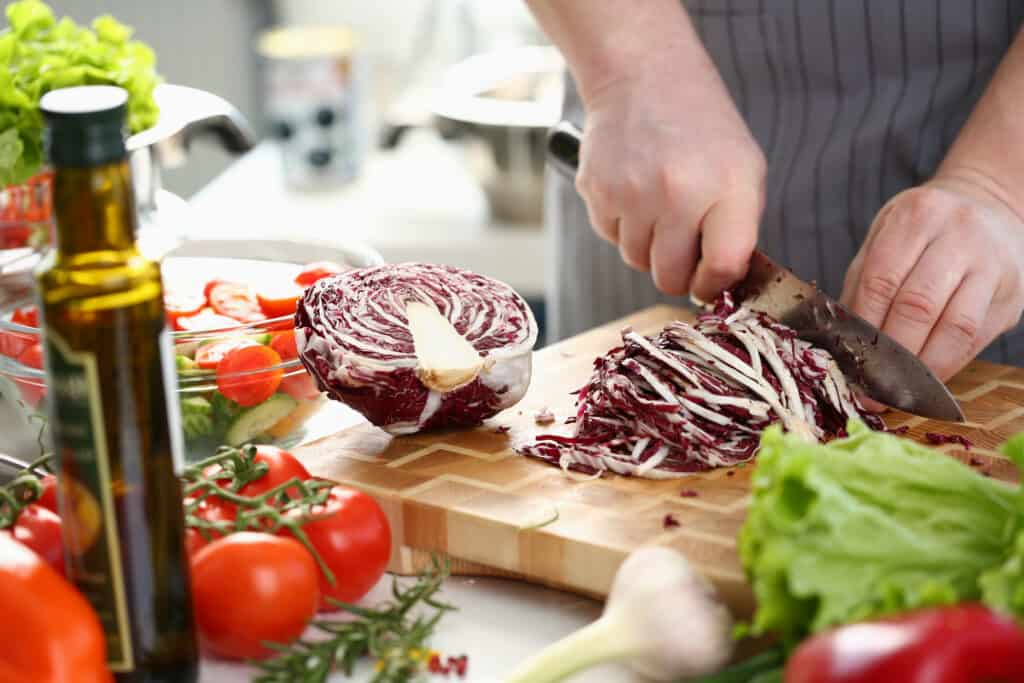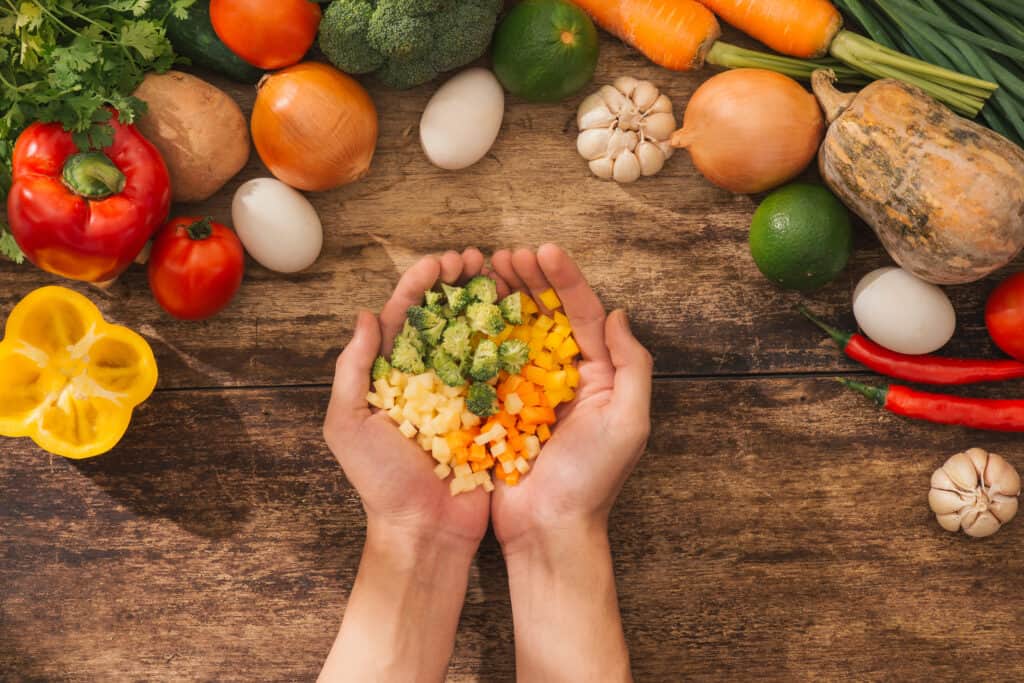From precise slicing to uniform dicing, these are the basic knife cuts every home chef must master. Join us as we delve into the art of knife cuts and uncover the secrets to slicing, dicing, and chopping like a pro, transforming you into a more skilled and efficient home chef.

Why knife cuts matter
In the world of culinary arts, mastering basic knife cuts is a fundamental skill that sets amateurs apart from professionals. Knife cuts matter for several reasons, but the most important ones are uniform cooking rates, visual presentation and consistent texture.
With most cooking techniques, smaller pieces cook faster, while larger pieces take longer. When all the pieces are of uniform size, you don’t have to worry about some being burnt while others are underdone. All of those same-size pieces reach an equal level of doneness simultaneously. This is key to improving your efficiency in the kitchen, and it also directly impacts the enjoyability of a meal.
We eat first with our eyes, and creating a visually appealing dish can elevate even the simplest ingredients. Precise and uniform pieces in consistent shapes simply make food look better. Combining the knowledge of cooking consistency with shape consistency also means that food will taste better because you know every bite will be the same bit of perfection.
By mastering knife cuts, you gain greater control over your cooking and enhance the overall quality of your culinary creations, two significant factors in elevating your skills from home cook to home chef.
Basic knife cuts
In a professional kitchen, the name of the cut changes is based not on the shape alone but also the precise size of the final product. This article covers six of the most basic knife cuts: chopping, mincing, chiffonade (shredding), julienne and batonnet, dicing and brunoise and slicing.
There is a strong possibility that you already use some of these techniques in your kitchen but don’t yet know it. Also included is an additional advanced cut that is surprisingly easy to do, fanning. It’s a style of cutting that is great for creating garnishes that make your food look and feel just a bit fancier.

Filled with appetizers, salads, sides, mains and desserts, Food Drink Life's cookbook will become your favorite!
- Easy and delicious recipes from a variety of top chefs and recipe developers.
- Bright, colorful pictures on every page.
- Printer-friendly recipes that you can download instantly to your device.
- Printable shopping list and a kitchen conversion sheet.
Chopping
Chopping is the most basic of knife cuts and it’s used to cut food into irregular, rough or coarse pieces that are of similar size and shape, but not exact. It’s used for preparing foods for soups, sauces and other preparation methods where the ingredients will be strained out or pureed.
To chop, hold the knife firmly in your dominant hand and wrap your fingers around the handle. Place your thumb and first knuckle on opposite sides of the handle or blade for stability and control. Then, use a straight, downward cutting motion to cut through the food.
Mincing
Mincing is a very fine version of chopping. It breaks down the ingredients into very small pieces that will almost melt into a dish. It is often used for garlic, shallots and herbs and is a great way to add flavor to a dish without altering the texture.
To mince, you must first chop the food into small manageable pieces. Then place the tip of the blade on the cutting board, and rock the blade back and forth, using the back part of the blade to cut the food, until you get the desired level of fineness.
Slicing
Slicing is another very basic knife cut. It refers to creating thin, flat pieces of the same thickness. It is one of the most common knife cuts and is used for everything from bread to cheese, fruits and vegetables.
To slice, cut the ingredient crosswise using evenly spaced, parallel slices. While it’s the same cut, when slicing a round vegetable the end result is a round instead of a slice.
“Learning some basic knife skills is essential in the kitchen. Understanding what knife to use, and how to keep your knives sharpened for clean cuts and safety is a must. Then knowing the different knife cuts that can affect the texture, flavor and even the cooking time of your food.”
— Jere Cassidy, One Hot Oven
Chiffonade (shredding)
Chiffonade, also called shredding, is a cut that creates a fine shred of equal thickness that is often used as a garnish or topping. It is most often used for herbs and leafy vegetables like lettuce, cabbage and basil.
To chiffonade stack the leaves together, then roll into a log or cylinder shape. Use your chef’s knife to make even, parallel cuts of the same thickness. Thicker slices will create a thicker shred, while thinner slices will create a thinner shred.
Julienne and batonnet
Julienne and batonnet refer to different sizes of the same long, rectangular shape. A julienned cut is one-eighth inch by one-eighth inch by one to two inches, while the batonnet cut is twice the size at one-quarter inch by one-quarter inch by two to two and a half inches. Larger cuts of this same shape are the pommes frites, a standard french fry cut, while a smaller version is the fine julienne.
To julienne, first square off the ingredients by trimming away enough of the vegetable to create four even sides, then trim the ends to create a solid square or rectangle shape. Next slice the vegetable with parallel cuts of even thickness. Finally, stack the slices and slice them with parallel cuts the same thickness as you used previously.

Dicing and brunoise
Dicing and brunoise cuts create small, perfectly cubed pieces. While brunoise refers to the smaller pieces, typically around one-eighth inch square and made from julienned ingredients, dicing is a larger cut that can be further broken down into small quarter-inch, medium half-inch, and large three-quarter-inch sizes.
To dice, you must first julienne your ingredient. Gather the sticks together and line them up against the blade of your knife, then cut them cross-wised at the same thickness as you used to create the julienne or batonnet.
Fanning
Fanning is not typically considered a basic knife cut, but it’s an easy-to-learn cut that creates fancy-looking garnishes that can really take your presentation skills to the next level. Fanning is commonly used for strawberries, avocados and peaches.
To fan, keeping the stem end intact use the tip of the knife blade to make thin, parallel slices that go all the way through the ingredient from just below the stem to the opposite end. Holding on to the intact stem, gently spread the cut fruit or vegetable into a fan shape.
Wrapping Up
Mastering basic knife cuts is a fundamental skill that every aspiring home chef should learn. These techniques not only enhance the aesthetics of a dish but also contribute to consistent cooking times and even distribution of flavors. Whether it’s dicing, julienning or mincing, understanding and practicing these knife cuts can elevate one’s culinary prowess and open up a world of creative possibilities in the kitchen. So grab your knife, sharpen your skills and embark on a culinary journey that embraces the artistry of precise knife cuts.
Renee N Gardner is the creative mastermind behind Renee Nicole’s Kitchen, a recipe blog based on seasonal ingredients, dedicated to helping home cooks build their kitchen confidence to become home chefs. When Renee isn’t writing, developing recipes, or photographing food, you’ll find her in the garden, traveling, or enjoying the outdoors with her husband, son, and two dogs.
